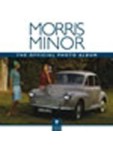Úvod »Automobily osobní a dodávky»Vanden Plas » Morris Minor 1000 Road Test Portfolio
Anotace
The feat, never before achieved by a British Motor manufacturer, deserved to be marked in a special way. The marketing department at BMC decided to produce a limited edition Morris Minor. Appropriately they called it the Minor Million and cleverly added another three noughts to the Morris 1000 badge. Not only that they painted the 350 limited edition models in a delicate shade of lilac and fitted a contrasting white interior with black piping. Chrome wheel rim embellishers added the final touch to what, in all other respects, were standard Morris 1000 2 door saloons. Sales continued to rise particularly on the home market where the Morris Minor had established an enviable reputation for economy and reliability. By 1962, the Morris Minor was facing tough competition from other BMC products including the Mini. Other models such as the Austin and Morris 1100 were destined to provide a threat to the market share the Morris Minor had traditionally enjoyed. Further updates followed with the introduction in 1962 of the Morris 1000, 1098cc A Series engine, a revised gearbox and improved braking. Then in 1964 the Morris Minor received what was destined to be the last ever major makeover when a revised dash layout, improved lighting, and a new range of interior trim colours were introduced. In an increasingly competitive market place it was inevitable that the Morris Minor would struggle to hold its own without a major facelift or a serious mechanical upgrade. That it stayed in production for so long and achieved the sales it did is remarkable and says much about the loyalty the cars inspired amongst its many owners. The catalyst for the inevitable decision to phase out Morris Minor production was the 1968 merger to form British Leyland. A review of the portfolio revealed that Morris Minor 1000 Convertible production had dwindled to a few hundred in 1968. Not surprisingly the decision was made to phase this model out first in 1969. A year later the 2 door and 4 door saloon models followed, much to the surprise of many. However the Traveller models and the Light Commercial van and pick-up models remained in production. Interestingly the LCV models were subjected to the then common practice of badge engineering. This resulted in Morris Minor vans and pick-ups being sold as Morris Minor models as well as Austin Vans and Pick-ups. Distinguishing features of the Austin models were the Austin 'crinkle' type front grille and Austin badges on the bonnet and the horn push. Production continued in the UK until 1971 when eventually a halt was called to both LCV and Traveller production. However in New Zealand production continued until 1973.
In retrospect, the decision to cease production probably made sense in purely commercial and business terms. However had sentiment played a part, then as in New Zealand, production may have continued for a little longer. With just over a million 948cc and 1098cc Morris 1000 variants built to add to the half a million split screen models built between 1948-1956, the Morris Minor had proved itself to be a motoring success story. Today, scores of Morris Minor Car clubs throughout the world continue to promote the continued use and preservation of the Morris Minor in all its guises. Proof, if proof were needed of the enduring popularity and versatility of one of the best British small family cars ever produced. Few can doubt the charismatic nature of the vehicles which are the subject of this publication or the durability of Alec Issigonis's basic design, conceived back in 1943. For owners past and present and classic car enthusiasts around the world. Reported on are the 2 and 4 door saloons, traveller estates, convertibles, pick-ups and vans. Included are road tests, service data, full specifications, owner reports, plus features on restoration and touring together with buying guides advising on acquiring a good Minor 1000. A total of 200 fully illustrated pages.



























